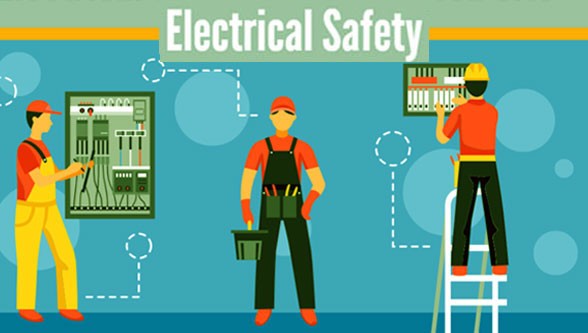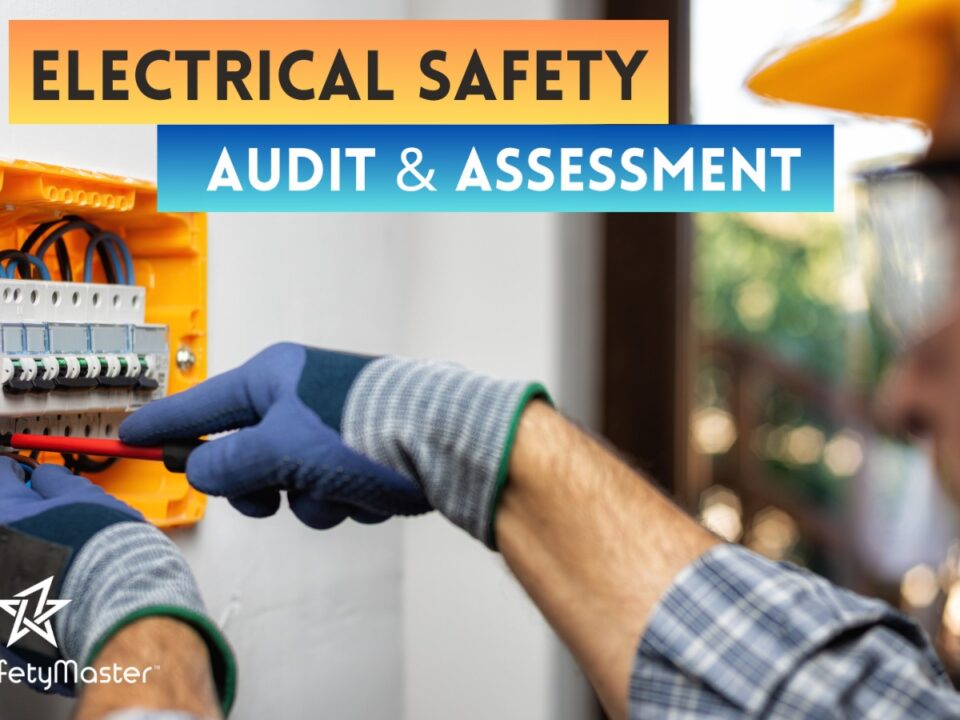Protecting Lives and Assets: How Electrical Safety Training Saves Businesses from Disasters

Hazardous area classification standards for flammable substances
October 5, 2023
Reducing Risk, Ensuring Success: Prioritizing Forklift Safety Training in India
October 5, 2023In this article, we delve into a critical aspect that often goes unnoticed in the business world: electrical safety training. While businesses prioritize their growth and profitability, they often neglect to consider the potential disasters that can arise from inadequate electrical precautions. However, by investing in comprehensive safety training, companies can shield themselves from catastrophic events and protect both their valuable assets and the lives of their employees. Join us as we unravel the importance of electrical safety training, its role in mitigating risks, and the invaluable peace of mind it brings to businesses. Discover how this proactive approach promises a solid foundation for a secure and thriving future.
Introduction
Imagine a world without electricity – the mere thought of it is unfathomable. Electricity plays an integral role in our daily lives, powering our homes and businesses, and fuelling technological advancements that have shaped our modern society. However, with great power comes great responsibility, especially when it comes to electrical safety. The potential dangers posed by electricity are not only a threat to individuals but also to businesses and their valuable assets. In this highly informative article, we will delve into the critical importance of electrical safety training for businesses. We will explore the common hazards that exist in workplaces, the dire consequences of neglecting electrical safety measures, and most importantly, how implementing comprehensive training programs can save businesses from disastrous outcomes. Whether you’re a business owner or an employee concerned about workplace safety, this article promises to provide you with invaluable insights that can protect lives and assets
The Importance of Electrical Safety Training
The Importance of Electrical Safety Training: In the realm of business operations, where efficiency and productivity are paramount, electrical safety training stands as a cornerstone for safeguarding lives and assets. A comprehensive understanding of electrical hazards and the adoption of preventive measures have become indispensable in today’s fast-paced technological landscape. By providing employees with the knowledge and skills to identify and manage electrical risks, businesses not only protect their workforce from potential disasters but also fortify their bottom line.
Electrical accidents can have catastrophic consequences, ranging from severe injuries to property damage or even loss of life. However, through rigorous training programs, businesses can cultivate a safety culture that empowers employees to mitigate risks proactively. By instilling awareness about electrical hazards and equipping workers with the necessary tools to handle potential dangers, organizations create an environment that promotes wellbeing while minimizing disruptions caused by accidents or emergencies.
Amidst the significant advancements in technology that drive modern enterprises forward, embracing electrical safety training showcases a commitment to excellence that resonates throughout an organization. It demonstrates proactive leadership and cultivates an atmosphere in which employees feel valued and protected. By prioritizing safety education, businesses inspire confidence in their workforce while simultaneously fostering a harmonious workplace where innovative ideas thrive without compromising on wellbeing.
Common Electrical Hazards in the Workplace
Electrical hazards lurk silently within workplaces, ready to strike at any moment with potentially catastrophic consequences. Understanding these hazards is the first crucial step towards safeguarding lives and assets. Faulty wiring, overloaded circuits, exposed electrical parts, and improper grounding are just a few examples of the dangers that can exist within a workplace. Each of these hazards has the potential to ignite fires, cause electric shocks, or trigger deadly explosions if left unaddressed. Consider for a moment a bustling manufacturing facility where countless electrical appliances and machinery hum incessantly. Amidst this symphony of productivity lies the risk of faulty wiring hidden behind walls or ceilings. This seemingly innocuous issue can quickly escalate into an inferno if not promptly detected and rectified. Similarly, overloading circuits by connecting multiple devices to a single outlet might seem like an innocent shortcut to efficiency but can pave the way for disastrous electrical fires that ravage entire buildings in mere minutes.
Furthermore, exposed electrical parts can spell doom for unsuspecting employees who inadvertently come into contact with them. A simple brush against an exposed wire jutting out from equipment could result in severe electric shocks that have lasting consequences on one’s physical well-being. Negligence when it comes to proper grounding also poses significant risks as it leaves individuals vulnerable to electrocution when faulty equipment malfunctions.
Awareness of these common electrical hazards empowers businesses to take proactive measures in mitigating risks and creating a safer working environment for all their stakeholders. By addressing these issues head-on through comprehensive training programs and meticulous workplace inspections, organizations can ensure they are well-prepared against potential disasters while fostering an optimistic culture where safety takes precedence over everything else
Consequences of Ignoring Electrical Safety
Consequences of Ignoring Electrical Safety: Failing to prioritize electrical safety within a business can have dire consequences, ranging from life-threatening incidents to substantial financial losses. The potential dangers are manifold. Consider the devastating impact of an electrical fire, which not only endangers the lives of employees but also jeopardizes valuable assets and critical business operations. Not only that, but electrocution hazards pose an imminent threat, with the potential to cause severe injuries or even fatalities in the workplace.
Furthermore, disregarding electrical safety protocols can lead to substantial financial burdens for businesses. Ignoring maintenance and inspection schedules can result in frequent equipment breakdowns and costly repairs. Moreover, non-compliance with electrical safety regulations may attract hefty fines and legal complications for businesses, tarnishing their reputation in the industry.
By acknowledging these consequences and taking proactive measures towards electrical safety training, businesses can safeguard their employees’ well-being while simultaneously protecting their assets and financial stability. A culture that prioritizes electrical safety not only fosters a secure work environment but also showcases a responsible and reputable image to clients and stakeholders alike.
How Electrical Safety Training Saves Businesses from Disasters
With its unyielding potential for catastrophic accidents, electrical hazards pose significant threats to businesses and their assets. However, through comprehensive electrical safety training, companies can effectively safeguard lives and protect valuable resources. By adhering to established safety standards and regulations, businesses demonstrate their commitment to creating a secure work environment. Electrical safety training programs play a vital role in the identification and mitigation of risks associated with electricity. Through these programs, employees gain the knowledge necessary to recognize potential hazards, such as faulty wiring or overloaded circuits. Armed with this awareness, they can take proactive measures to prevent accidents before they occur. Additionally, training empowers employees with the skills needed to handle electrical emergencies swiftly and effectively.
Implementing regular equipment maintenance and inspection protocols is another critical aspect of electrical safety training. Faulty or outdated equipment can increase the risk of electrical incidents exponentially. By instilling a culture of thorough maintenance checks and prompt repairs, businesses reduce the likelihood of equipment malfunctions that may compromise employee safety or damage valuable assets.
In conclusion, investing in comprehensive electrical safety training is an indispensable strategy for businesses aiming to protect lives and assets from potential disasters caused by electrical hazards. Through adherence to regulations, identification of risks, proper employee training on procedures, equipment maintenance protocols, and emergency preparedness efforts – companies can create a secure work environment that fosters productivity while ensuring the well-being of their workforce.
Compliance with Electrical Safety Standards and Regulations
Compliance with Electrical Safety Standards and Regulations: In today’s complex business landscape, adhering to electrical safety standards and regulations is not only a legal obligation but also a moral responsibility. These guidelines have been meticulously designed to protect the lives of employees, prevent accidents, and safeguard valuable assets. By ensuring compliance, businesses demonstrate their commitment to creating a safe working environment that fosters employee well-being and productivity.
Electrical safety standards and regulations are established by regulatory bodies to set the benchmark for best practices in the industry. These include guidelines for equipment installation, maintenance procedures, and safety protocols. By following these standards, businesses guarantee that their electrical systems are designed, installed, operated, and maintained in a manner that minimizes risks and maximizes efficiency.
Moreover, compliance with these regulations provides peace of mind for business owners as they can rest assured that their operations are upholding the highest safety standards. This not only prevents potential accidents but also protects businesses from potential legal liabilities or financial losses due to non-compliance. Embracing electrical safety standards leads to a culture of responsibility within organizations while fostering trust among stakeholders.
By prioritizing compliance with electrical safety standards and regulations, businesses demonstrate their commitment towards protecting lives and assets. They create an environment where employees can work without fear of electrical hazards. Ultimately, this dedication leads to increased employee morale and productivity while enhancing the overall reputation of the business within its industry.
Identification and Mitigation of Electrical Risks
Identification and Mitigation of Electrical Risks: Workplaces are rife with potential electrical risks, lurking behind walls and under floors. The first step in protecting lives and assets is to identify these hidden dangers. A thorough assessment must be conducted by trained professionals who can meticulously scrutinize the entire electrical infrastructure. This process involves examining wiring systems, circuit breakers, outlets, grounding systems, and all other components that could potentially pose a hazard.
Once the hazards have been identified, it is crucial to develop effective strategies for mitigating them. This may involve implementing engineering controls such as installing ground fault circuit interrupters (GFCIs) or isolation transformers. In addition, proper labelling of electrical panels and equipment is essential for quick identification during emergencies. Moreover, regular maintenance checks should be carried out to ensure that all electrical components remain in optimal condition.
By proactively identifying and effectively mitigating electrical risks, businesses can create a safe working environment for their employees while safeguarding their valuable assets. Taking these necessary precautions not only prevents accidents but also reduces downtime due to equipment failures or electrical malfunctions. Moreover, by prioritizing safety through risk identification and mitigation measures, businesses foster a culture of care for their employees’ well-being—a culture that inspires productivity and loyalty within the workforce.
Remember: vigilance in identifying electrical risks coupled with swift action to mitigate them is an investment that pays dividends in terms of safety, peace of mind, and ultimately success for businesses large and small alike
Training Employees on Electrical Safety Procedures
Training Employees on Electrical Safety Procedures: Properly training employees on electrical safety procedures is crucial to minimize the risks associated with electrical hazards in the workplace. By imparting comprehensive knowledge about safe practices and protocols, businesses can empower their workforce to make informed decisions and take necessary precautions. One vital aspect of this training involves instructing employees on identifying potential electrical hazards, such as damaged cords or faulty outlets, and emphasizing the importance of promptly reporting any concerns to supervisors.
During training sessions, employees should be educated on how to safely handle electrical equipment and machinery. This includes guidance on proper usage techniques, such as never overloading outlets or using worn-out tools. Additionally, they should be trained on the correct use of personal protective equipment (PPE), such as insulated gloves or safety goggles, which serve as a vital defence against potential electric shocks or arc flashes.
Moreover, incorporating hands-on demonstrations and practical exercises into the training program can greatly enhance employee understanding and retention. By simulating various workplace scenarios involving electricity-related emergencies, employees can practice implementing safety procedures under controlled circumstances. This instils confidence in their ability to respond effectively during real-life situations while fostering a sense of responsibility towards ensuring a secure working environment for themselves and their colleagues.
By prioritizing comprehensive training that covers both theoretical knowledge and practical applications for employees at all levels of an organization, companies demonstrate their commitment towards fostering a culture of safety awareness. When individuals are equipped with the necessary skills to identify potential risks and take appropriate action, businesses can significantly reduce accidents related to electrical hazards while safeguarding the lives and assets within their premises.
Equipment Maintenance and Inspection
Equipment Maintenance and Inspection: Ensuring the smooth functioning of electrical equipment is crucial for maintaining a safe working environment. Regular maintenance and inspection protocols play a pivotal role in preventing accidents and potential disasters. By conducting routine checks on electrical equipment, such as transformers, circuit breakers, and cables, businesses can detect any signs of wear or malfunction before they escalate into hazardous situations.
During maintenance activities, trained professionals meticulously examine the condition of electrical components. They inspect for loose connections, damaged insulation, overheating, or any other anomalies that could compromise the safety of both personnel and assets. Through preventive measures like tightening connections, lubricating moving parts, and replacing worn-out components, potential hazards are effectively minimized.
By implementing a comprehensive maintenance program in conjunction with regular inspections, businesses can extend the lifespan of their electrical equipment while reducing downtime due to unexpected failures or breakdowns. This proactive approach not only saves money on costly repairs but also instils confidence in employees who can carry out their tasks without fear of encountering faulty equipment. Ultimately, a well-maintained electrical infrastructure promotes productivity and fosters an optimistic work environment where employees feel secure and motivated to perform at their best.
Emergency Response and Preparedness
Emergency Response and Preparedness: In the realm of electrical safety, being prepared for emergencies is paramount. Electrical accidents can occur unexpectedly, and without proper response measures in place, the consequences can be catastrophic. To safeguard lives and assets, businesses must prioritize emergency response and preparedness as an integral part of their electrical safety training programs.
During an electrical emergency, time is of the essence. Employees need to be trained on how to promptly identify and respond to potential hazards such as electric shocks, fires, or equipment malfunctions. This includes knowing how to safely shut off power sources, activate fire suppression systems, and provide immediate first aid to injured individuals. Regular drills and simulations can enhance employees’ preparedness so that they can act swiftly and confidently in these high-pressure situations.
Furthermore, businesses must establish clear communication protocols during emergencies. This involves developing well-defined evacuation plans, ensuring that emergency exits are easily accessible and well-marked throughout the premises. By establishing a hierarchy of communication channels that include both visual cues (such as warning signs) and auditory signals (such as alarms or intercoms), companies can effectively guide their employees towards safety.
By prioritizing emergency response training and preparedness measures within their electrical safety programs, businesses not only protect lives but also minimize potential damage to their assets. Such proactive measures create a culture of safety within organizations by instilling confidence among employees that their well-being is valued above all else. In turn, this cultivates a positive work environment where individuals feel safe, motivated, and empowered to contribute to the success of the business
Benefits of Implementing Electrical Safety Training Programs
Implementing electrical safety training programs in businesses brings forth a multitude of benefits that far surpass initial investments. Firstly, such programs foster a culture of awareness and responsibility among employees, empowering them to take charge of their own safety and that of their colleagues. This heightened sense of vigilance ensures that potential hazards are promptly identified and mitigated, minimizing the risk of accidents or disasters. Secondly, by equipping employees with the necessary knowledge and skills to handle electrical equipment safely, businesses can significantly reduce downtime caused by equipment malfunctions or accidents. This translates into improved productivity and seamless operations, boosting overall efficiency within the organization.
Moreover, implementing electrical safety training programs demonstrates a company’s commitment to employee well-being and regulatory compliance. By adhering to industry standards and regulations, businesses not only safeguard their workforce but also enhance their reputation as responsible corporate citizens. This positive image fosters trust among stakeholders, including clients, suppliers, and investors.
In conclusion, the benefits derived from implementing electrical safety training programs are manifold: a safer work environment for employees; reduced downtime due to accidents or equipment failures; enhanced reputation as a responsible business; increased stakeholder trust; ultimately leading to improved productivity and profitability. Therefore, investing in comprehensive electrical safety training is not only ethically imperative but also economically advantageous for businesses seeking long-term success.
Conclusion
In conclusion, embracing electrical safety training is not only a prudent decision but also a crucial investment for businesses to protect their most valuable assets: their employees and infrastructure. By prioritizing the identification, mitigation, and prevention of electrical hazards through comprehensive training programs, businesses can significantly minimize the risks of accidents, injuries, or even catastrophic disasters. Additionally, fostering a culture of safety and accountability within the organization will not only enhance productivity and efficiency but also create a working environment where employees feel valued and protected. Ultimately, by embracing electrical safety as an integral part of their operations, businesses can pave the way toward a brighter future filled with prosperity and peace of mind.
How We Can Help?
TSM TheSafetyMaster Pvt Ltd offers wide range of learning development sessions on Electrical Safety Training,
- Basic Awareness Course on Electrical Safety
- 2-Day Electrical Safety Mastery Course
- LOTO Awareness Training
- Advanced LOTO system Implementation Training



